Persuasive Request Letter
[Your Name]
[Your Address]
[City, State, ZIP Code]
[Email Address]
[Phone Number]
[Date]
[Recipient's Name]
[Recipient's Job Title]
[Company/Organization Name]
[Address]
[City, State, ZIP Code]
Subject: Persuasive Request for [Your Request]
Dear [Recipient's Name],
I hope this letter finds you in good health and high spirits. My name is [Your Name], and I am writing to you with a persuasive request that I believe will be of great mutual benefit to both parties involved.
[Begin by introducing yourself and your background briefly. State any relevant affiliations or shared interests with the recipient or their organization to establish a connection.]
The purpose of my letter is to request [state your specific request clearly]. After careful consideration and research, I am convinced that this proposition presents a unique opportunity for your esteemed organization to achieve [mention the benefits or opportunities for the recipient].
Allow me to outline the key reasons why I believe my request is worth your serious consideration:
1. Mutual Benefits: The implementation of [your request] will lead to mutual benefits for both our organizations. It will provide a chance for collaboration that can unlock new opportunities and lead to shared success.
2. Expertise and Skills: My background in [mention your expertise and skills] makes me confident in my ability to deliver on this request effectively and efficiently. Your organization will gain from the specialized skills and insights I can contribute.
3. Previous Success: Similar requests have proven successful in other contexts, resulting in [mention successful outcomes achieved elsewhere]. This indicates the potential for positive results in our partnership.
4. Shared Values: As I have followed your organization's achievements and values, I am convinced that we share common ground. Our collaboration will not only enhance both our positions but also contribute positively to our stakeholders and the community at large.
5. Commitment: I assure you of my full commitment and dedication to the success of this endeavor. I am open to discussions, modifications, and adjustments to ensure that we arrive at a mutually agreeable arrangement.
In light of the above points, I kindly request an opportunity to discuss this matter further at your earliest convenience. I believe that a personal meeting or a phone call would allow us to explore the possibilities in more depth and address any questions or concerns you may have.
Thank you for considering my request. I am eagerly looking forward to the possibility of collaborating with your esteemed organization. Please find my contact information at the beginning of this letter.
Sincerely,
[Your Name]
Request for Workplace Flexibility or Remote Work
Subject: Request for Flexible Work Arrangement
Dear [Manager's Name],
I am writing to formally request a flexible work arrangement that would allow me to [work remotely two days per week/adjust my schedule/work from home full-time]. I believe this arrangement would enable me to maintain my productivity while better managing my personal circumstances.
Over the past [time period], I have consistently met all deadlines and exceeded performance expectations in my role as [position]. I am confident that this flexibility would not compromise my work quality or team collaboration. In fact, studies show that flexible arrangements often increase employee productivity and job satisfaction.
I propose the following arrangement: [specific details of schedule, days, hours]. I would ensure full availability during core business hours and maintain regular communication through [tools/methods]. All my current responsibilities and deliverables would continue without interruption.
I would appreciate the opportunity to discuss this request with you at your earliest convenience. I am open to a trial period to demonstrate the effectiveness of this arrangement.
Thank you for considering my request. I look forward to your response.
Sincerely,
[Your Name]
Request for Salary Increase or Promotion
Subject: Request for Compensation Review
Dear [Manager's Name],
I am writing to request a review of my current compensation package. Since joining [company name] [time period] ago, I have taken on significant additional responsibilities and consistently delivered results that exceed expectations.
During my tenure, I have accomplished the following: [list 3-5 specific achievements with measurable results]. These contributions have directly impacted [department/company goals] and generated [specific value, if quantifiable].
Based on my research of current market rates for [position] with my level of experience and qualifications, I believe my compensation is below industry standards. Additionally, colleagues in similar roles at comparable companies are earning [percentage or range] more.
I am requesting a salary adjustment to [specific amount or range], which I believe fairly reflects my contributions, market value, and the expanded scope of my role. I am committed to continuing to deliver exceptional results for our team.
I would welcome the opportunity to discuss this matter with you in detail. Please let me know when would be convenient for you to meet.
Thank you for your time and consideration.
Best regards,
[Your Name]
Request for Extended Leave or Time Off
Subject: Request for Extended Leave of Absence
Dear [Manager's Name],
I am writing to request an extended leave of absence from [start date] to [end date] due to [personal/family/medical reasons]. This is a carefully considered decision, and I wanted to provide you with as much advance notice as possible.
The reason for my request is [brief, appropriate explanation without excessive personal details]. This time away is essential for me to [address this situation/care for family member/recover fully] and return to work with full focus and energy.
To ensure minimal disruption to our team and projects, I propose the following plan: [outline transition plan, coverage arrangements, handover of responsibilities]. I am committed to completing all urgent tasks before my departure and providing comprehensive documentation for whoever will cover my duties.
If possible, I would like to remain available for critical questions via email during my absence, though my responses may be delayed. I am also happy to discuss a gradual return-to-work schedule if that would be helpful.
I understand this request requires careful consideration and planning. I am available to discuss this matter further and work together on the best solution for both the team and my situation.
Thank you for your understanding and support during this time.
Respectfully,
[Your Name]
Request for Educational or Training Support
Subject: Request for Professional Development Support
Dear [Manager's Name],
I am writing to request support for a professional development opportunity that would significantly enhance my skills and benefit our organization. I would like to enroll in [course name/certification program/conference] scheduled for [dates].
This program focuses on [subject area] and would directly apply to my current role and future projects. Specifically, I would gain expertise in [list key skills or knowledge areas]. These capabilities would enable me to [specific benefits to company/team/projects].
The total investment required is [amount], which covers [tuition/registration fees/materials/travel]. I am requesting that the company cover [full amount/percentage] of these costs. In return, I commit to [complete the program successfully/share knowledge with team/apply skills to specific projects/remain with company for specified period].
I have researched several options and believe this program offers the best value and relevance to our work. The schedule would allow me to [maintain my current responsibilities/study outside work hours/require minimal time away from office].
I would be happy to provide additional information about the program, including syllabus, outcomes, and testimonials from past participants. I am confident this investment would yield significant returns for both my professional growth and our team's capabilities.
Thank you for considering this request. I look forward to discussing it with you.
Best regards,
[Your Name]
Request for Equipment, Resources, or Budget
Subject: Request for Additional Resources for [Project/Department]
Dear [Manager's Name],
I am writing to request approval for additional resources that would significantly improve our productivity and project outcomes. Specifically, I am requesting [equipment/software/budget allocation/additional staff] for [purpose].
Currently, we are facing challenges with [describe limitations or problems]. These constraints are impacting our ability to [specific effects on work/deadlines/quality]. The requested resources would address these issues by [explain how].
I am requesting the following: [detailed list with costs]. The total investment would be [amount]. Based on my analysis, this would result in [quantified benefits such as time savings, increased output, cost reduction, improved quality].
The return on investment can be measured through [specific metrics]. I estimate we would see positive results within [timeframe], and the long-term benefits include [list advantages].
Alternative options I considered include [other solutions], but the requested approach offers [reasons why it's superior]. I have obtained quotes from [number] vendors and recommend [specific vendor] based on [criteria].
I have prepared a detailed proposal with additional information and am happy to present it to you or the relevant decision-makers. This investment would position us to [achieve specific goals or overcome specific challenges].
Thank you for considering this request. I am available to discuss any questions or concerns.
Sincerely,
[Your Name]
Request for Policy Change or Exception (Casual-Professional)
Subject: Request for Policy Exception
Hi [Manager's Name],
I'm reaching out to request an exception to [specific policy] in my situation. I understand the policy exists for good reasons, but I believe my circumstances warrant special consideration.
Here's my situation: [explain circumstances clearly and concisely]. This is creating challenges because [describe impact]. I've explored all standard options, including [list alternatives tried], but none adequately address my needs.
I'm requesting [specific exception or modification]. This would allow me to [desired outcome] while still respecting the spirit and intent of the original policy. To ensure this doesn't set an unwanted precedent, I suggest [conditions or limitations on the exception].
I've thought through the implications and I'm prepared to [commitments you're willing to make]. I believe this solution is fair and reasonable given the circumstances.
I really appreciate you taking the time to consider this request. I'm happy to discuss it further and provide any additional information that would be helpful.
Thanks so much for your consideration.
Best,
[Your Name]
Request for Vendor Services or Partnership
Subject: Request for Proposal - [Service/Project Name]
Dear [Vendor Contact Name],
I am writing on behalf of [company name] to request a proposal for [services/products] that would support our upcoming [project/initiative].
Our organization is [brief company description] and we are currently [context for the need]. We are seeking a qualified vendor who can provide [specific services/products] to help us achieve [objectives].
The scope of work would include: [detailed list of requirements, deliverables, and specifications]. The project timeline is [dates], with an expected completion date of [date]. Our budget range for this project is [amount or range, if appropriate to share].
We would like your proposal to address the following: [list specific questions or requirements such as pricing structure, timeline, team qualifications, relevant experience, approach/methodology, references].
Key considerations for vendor selection include [criteria such as experience, cost, timeline, quality, support]. We are particularly interested in vendors who have [specific qualifications or experience].
Please submit your proposal by [deadline date]. We plan to make our selection by [date] and begin work on [date]. Proposals should be sent to [email address] with the subject line "[Reference Number/Project Name]."
If you have any questions about this request or need clarification on any requirements, please don't hesitate to contact me at [phone] or [email].
We look forward to reviewing your proposal.
Sincerely,
[Your Name]
[Title]
[Contact Information]
Request for Donation or Sponsorship (Heartfelt-Professional)
Subject: Sponsorship Opportunity for [Event/Cause]
Dear [Recipient Name],
I am writing to request your support for [organization/event/cause], which is making a meaningful difference in [community/field/lives of beneficiaries].
Our mission is to [describe purpose]. Over the past [timeframe], we have [achievements and impact]. However, we cannot continue this important work without the generous support of partners like you.
We are currently seeking sponsors for [specific program/event] scheduled for [date]. This [event/initiative] will [describe what it does and who it helps]. Last year, we served [number] people and achieved [specific outcomes].
We are offering several sponsorship levels: [list tiers with benefits at each level]. Your contribution would directly fund [specific uses of funds] and you would receive [recognition and benefits].
Your company's values align closely with our mission, particularly your commitment to [relevant company values or initiatives]. A partnership would demonstrate your dedication to [shared values] while providing your organization with [benefits such as visibility, community goodwill, networking opportunities].
Every dollar contributed makes a real difference. [Include a brief story or example of impact if possible]. With your support, we can [specific goals].
I would love to discuss this opportunity with you in more detail. Please let me know if you would like to meet or if you need any additional information about our organization or this sponsorship opportunity.
Thank you for considering this request and for your commitment to making a positive impact.
With gratitude,
[Your Name]
[Title]
[Organization]
[Contact Information]
What is a Persuasive Request Letter and Why Do You Need One
A persuasive request letter is a formal or semi-formal written communication designed to convince the recipient to grant a specific request, approve an action, or provide resources. Unlike simple informational letters, persuasive request letters require strategic argumentation, evidence, and compelling reasoning to achieve their objective. These letters are essential in professional, academic, and personal contexts when you need something that requires another person's approval, authorization, or cooperation. The purpose is to present your case so effectively that the recipient feels motivated or obligated to respond favorably, even when granting your request may not be their initial inclination.
When Do You Need to Send a Persuasive Request Letter
- When requesting budget approval for projects, equipment, or resources that exceed your authority level
- During salary negotiation or when requesting a promotion that requires manager approval
- When seeking exceptions to established policies, rules, or procedures
- Before requesting extended leave, flexible work arrangements, or schedule modifications
- When applying for scholarships, grants, or funding opportunities
- During vendor selection processes when requesting proposals or service agreements
- When seeking sponsorships or donations for events, causes, or organizations
- Before requesting professional development support including training, courses, or conference attendance
- When proposing new initiatives, programs, or changes that require stakeholder buy-in
- During conflict resolution when requesting accommodation or compromise from other parties
How to Write an Effective Persuasive Request Letter
- Begin by clearly stating your request in the opening paragraph without burying it in pleasantries
- Research your recipient's priorities, concerns, and decision-making criteria before writing
- Build your case using specific evidence, data, examples, and concrete details rather than vague statements
- Address potential objections proactively by acknowledging concerns and providing counterarguments
- Frame your request in terms of benefits to the recipient or organization, not just your personal needs
- Use a structure that moves from context to request to justification to action items
- Maintain a respectful, professional tone even when making requests that challenge existing decisions
- Include specific details about implementation, timeline, costs, and your commitments
- Propose solutions or alternatives that demonstrate flexibility and willingness to compromise
- End with a clear call to action and make it easy for the recipient to respond or take next steps
- Proofread carefully to ensure your letter is error-free and professionally formatted
Who Should Send a Persuasive Request Letter
- Employees requesting changes to compensation, working conditions, or career advancement
- Managers or team leaders seeking resources, budget, or approval for departmental initiatives
- Students or researchers applying for funding, grants, scholarships, or institutional support
- Nonprofit organizations seeking donations, sponsorships, or partnerships from businesses or individuals
- Vendors or service providers responding to requests for proposals or pitching their services
- Project managers requesting additional resources, timeline extensions, or scope modifications
- Human resources professionals proposing policy changes or new programs
- Individuals seeking accommodations for disabilities, health conditions, or personal circumstances
- Community organizers requesting support from government agencies or local businesses
- Anyone who needs formal approval or authorization for actions outside their direct control
To Whom Should a Persuasive Request Letter Be Addressed
- Direct supervisors or managers who have authority to approve your specific request
- Senior executives or decision-makers when requests exceed middle management authority
- Human resources departments for policy-related requests or employee accommodations
- Budget holders or financial officers when requesting funding or resource allocation
- Committee members or boards when seeking group approval or institutional support
- Vendors, suppliers, or service providers when requesting proposals, modifications, or partnership terms
- Donors, sponsors, or philanthropic organizations when seeking financial support
- Academic institutions, departments, or committees when applying for grants or positions
- Government agencies or officials when requesting permits, exceptions, or public support
- Always address the letter to a specific person by name rather than using generic titles when possible
Formatting Guidelines for Persuasive Request Letters
- Keep length between 250-500 words for most professional requests; longer for complex proposals requiring extensive detail
- Use business letter format for formal requests and email format for routine or semi-formal requests
- Structure with clear paragraphs: opening (request), body (justification), closing (action items)
- Maintain professional tone for workplace requests; adjust to slightly more casual for internal communications
- Use formal salutations ("Dear Mr./Ms./Dr.") for external or very formal requests
- Include subject lines that clearly indicate the request type for emails
- Utilize bullet points or numbered lists when presenting multiple points, options, or benefits
- Attach supporting documents separately rather than embedding lengthy details in the letter body
- Sign formally for printed letters; use professional email signatures for digital communications
- Choose delivery method based on urgency and formality: printed letters for major requests, emails for routine matters
Requirements and Prerequisites Before Sending Your Request
- Verify that you're addressing the correct decision-maker who has authority to grant your request
- Research organizational policies, procedures, and precedents related to your request
- Gather all supporting documentation including quotes, data, research, or performance records
- Calculate specific costs, timeframes, and resource requirements with accurate figures
- Identify potential objections and prepare evidence-based responses to each concern
- Review similar successful requests to understand what arguments and formats worked previously
- Confirm the appropriate timing for your request considering budget cycles, workload, or organizational priorities
- Ensure you have fulfilled any prerequisite requirements such as tenure, performance standards, or eligibility criteria
- Prepare to offer compromises or alternatives if your primary request cannot be fully granted
- Have someone review your letter for clarity, persuasiveness, and professionalism before sending
What to Do After Sending Your Persuasive Request Letter
- Send a confirmation email if you submitted a printed letter to ensure receipt
- Wait an appropriate period (typically 3-7 business days) before following up, unless urgency dictates otherwise
- Prepare for a meeting or phone call to discuss your request in greater detail
- Be ready to provide additional information, clarification, or documentation if requested
- Respond promptly and professionally to any questions or concerns raised by the recipient
- If denied, request feedback on why and ask what would need to change for approval in the future
- Send a thank you note regardless of the outcome to maintain positive relationships
- Document the response and any commitments made by either party for future reference
- If approved, fulfill any commitments or conditions you agreed to in your request
- Keep stakeholders informed of the outcome if your request affects others
Common Mistakes to Avoid When Writing Persuasive Request Letters
- Making the request too vague or burying it deep in the letter rather than stating it clearly upfront
- Focusing solely on your needs without explaining benefits to the recipient or organization
- Using emotional appeals or guilt rather than logical arguments and evidence
- Failing to anticipate and address obvious objections or concerns
- Including excessive personal details or explanations that aren't relevant to the decision
- Making demands or using entitled language instead of respectful requests
- Submitting requests at inappropriate times such as during crisis periods or budget freezes
- Failing to proofread, resulting in typos or grammatical errors that undermine credibility
- Not providing specific details about costs, timelines, or implementation plans
- Sending to the wrong person or going over your manager's head without proper justification
- Making unrealistic promises or commitments you cannot fulfill if the request is granted
- Being too lengthy and losing the reader's attention, or too brief and failing to justify the request
Advantages and Disadvantages of Persuasive Request Letters
Advantages:
- Provides formal documentation of your request and the rationale behind it
- Allows recipient time to consider your arguments without pressure of immediate response
- Creates a paper trail that can be referenced in future discussions or decisions
- Enables you to present a well-organized, thoroughly researched case
- Demonstrates professionalism and respect for formal processes
- Can be shared with multiple stakeholders who need to approve the request
Disadvantages:
- Takes more time to prepare than verbal requests, potentially delaying outcomes
- Lacks the personal connection and rapport-building of face-to-face conversations
- Cannot adapt arguments in real-time based on recipient's reactions or concerns
- May feel overly formal for simple requests in casual workplace cultures
- Creates a permanent record that could be used against you if poorly worded
- Recipient can ignore or delay response more easily than with in-person requests
Comparing Persuasive Request Letters with Alternative Approaches
Persuasive Request Letter vs. Verbal Request: Letters provide documentation and allow for more detailed argumentation, while verbal requests enable immediate feedback and relationship building. Use letters for formal situations requiring approval chains; use verbal requests for simple matters or when relationships are paramount.
Formal Letter vs. Email Message: Printed letters convey greater formality and importance but take longer to deliver. Emails are faster and appropriate for most modern business requests. Choose printed letters for major requests like significant policy exceptions; use emails for routine professional requests.
Direct Request vs. Proposal: Simple request letters state what you need and why. Proposals provide extensive detail about implementation, alternatives, and comprehensive justification. Use request letters for straightforward asks; develop full proposals for complex initiatives requiring substantial resources.
Individual Request vs. Petition: Individual letters represent personal needs and build one-on-one relationships. Petitions demonstrate collective support but may seem confrontational. Request individually when it's your personal matter; petition when seeking changes that benefit many people.
Essential Elements and Structure of Persuasive Request Letters
- Subject Line (for emails): Clear, specific indication of request type and purpose
- Opening Salutation: Formal greeting addressing recipient by name and appropriate title
- Introduction Paragraph: Immediate statement of your request without excessive preamble
- Context Section: Brief background explaining why you're making this request now
- Justification Body: 2-3 paragraphs presenting evidence, benefits, and reasoning
- Objection Management: Acknowledgment of potential concerns with counter-arguments
- Specific Details: Concrete information about costs, timelines, commitments, and implementation
- Call to Action: Clear statement of what you want the recipient to do next
- Closing Remarks: Expression of appreciation and openness to discussion
- Formal Signature: Your name, title, contact information
- Attachments: Supporting documents referenced in the letter (quotes, data, research, proposals)
Tips and Best Practices for Persuasive Request Letters
- Lead with your strongest argument rather than building up to it gradually
- Use specific numbers and concrete examples instead of generalizations and adjectives
- Mirror the recipient's communication style and organizational values in your language
- Time your request strategically around budget cycles, performance reviews, or project milestones
- Offer to provide additional information or meet to discuss rather than requiring full decision immediately
- Keep paragraphs short (3-4 sentences) to maintain readability and engagement
- Use active voice and strong verbs to convey confidence without arrogance
- Reference relevant policies, precedents, or previous approvals that support your case
- Demonstrate that you've done homework by mentioning research, market rates, or industry standards
- Make it easy to say yes by suggesting trial periods, phased implementation, or compromise solutions
- End positively regardless of anticipated outcome to preserve relationship for future interactions

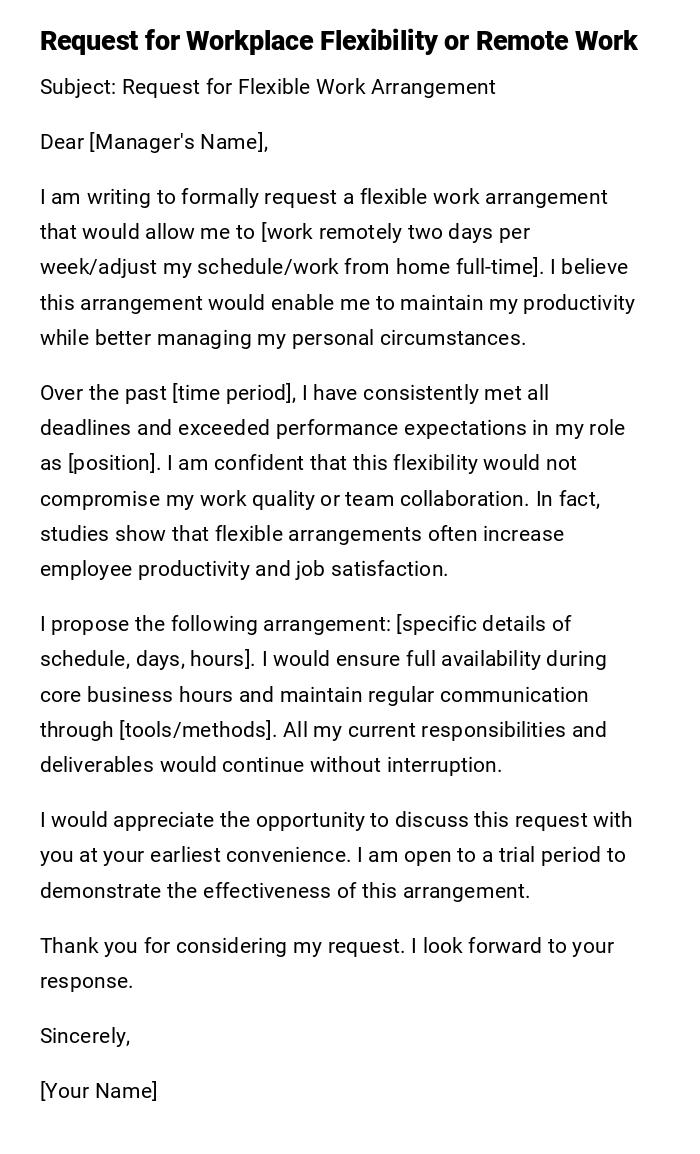
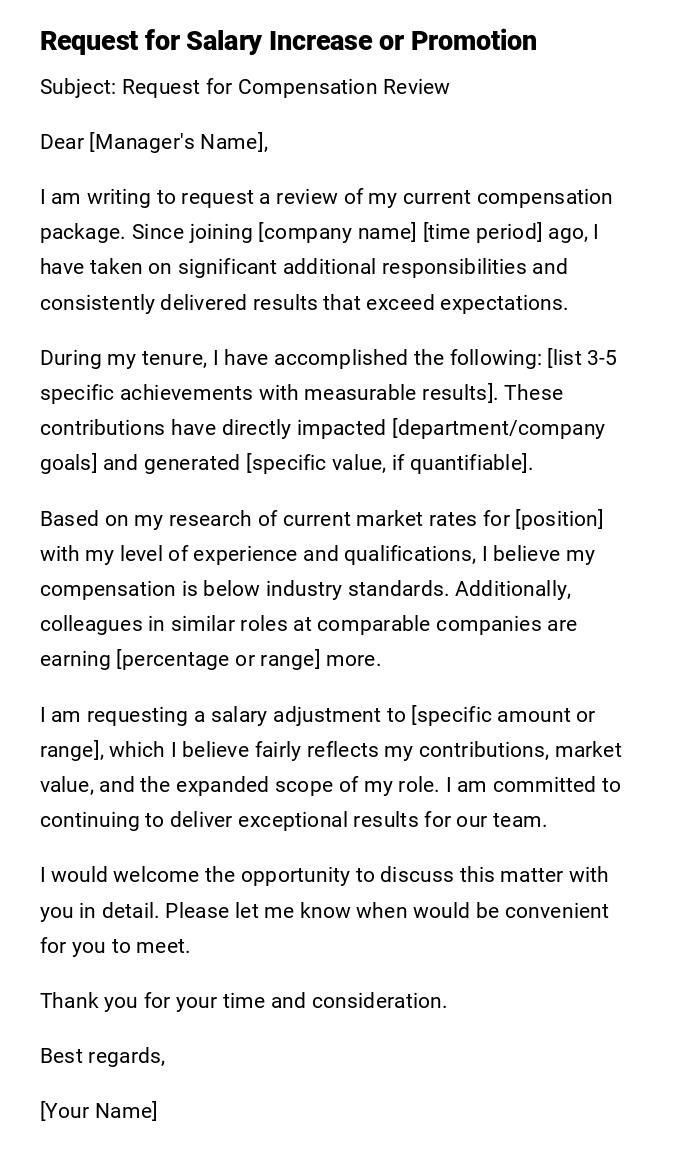
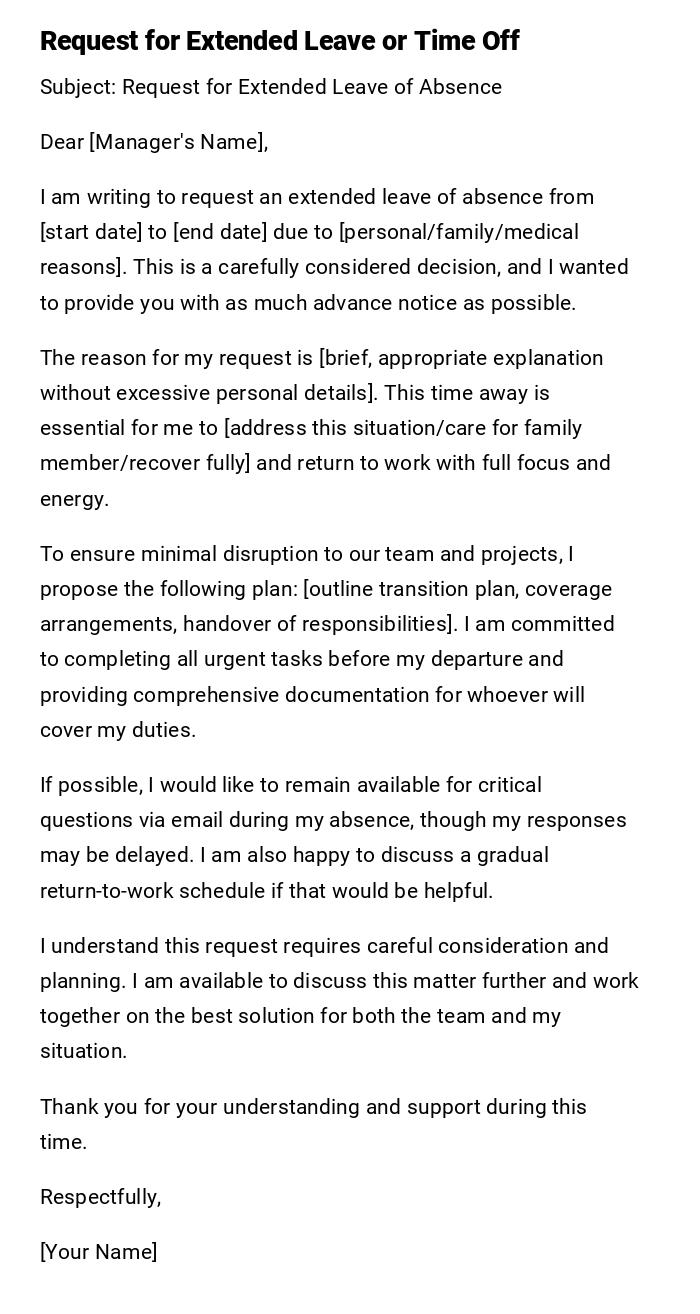
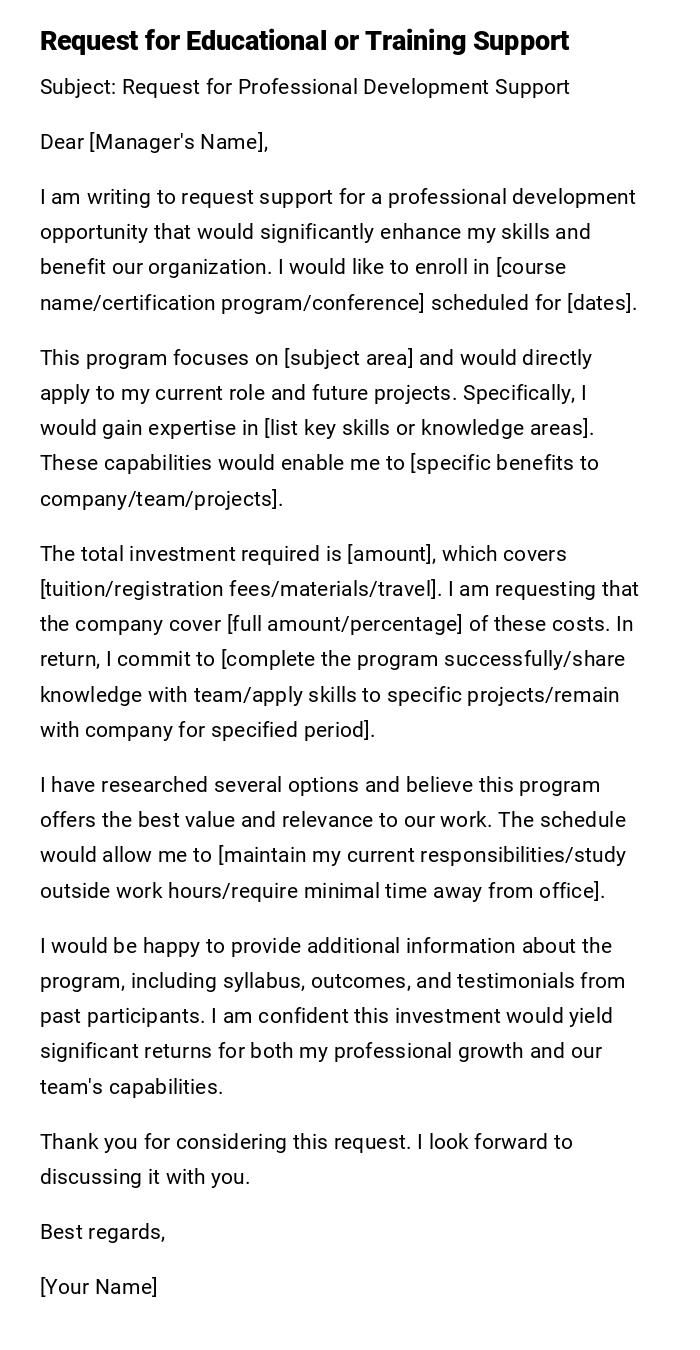
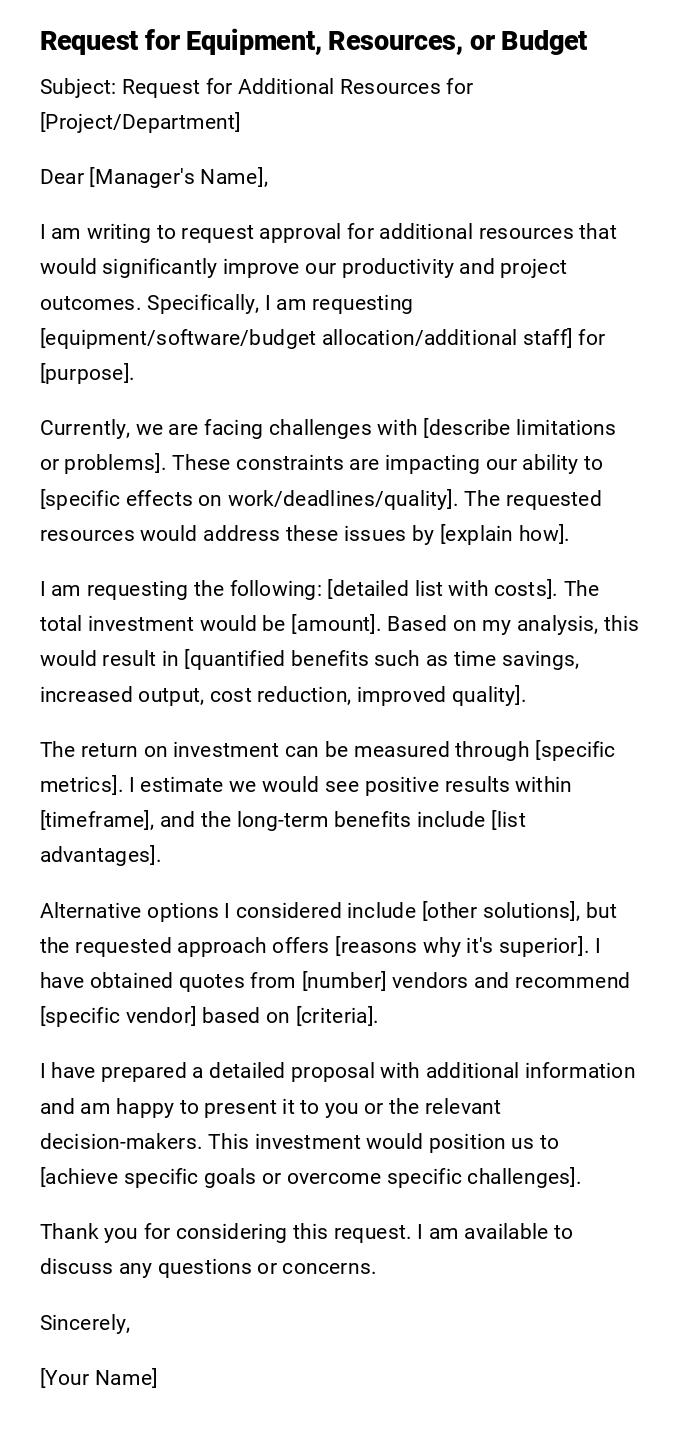
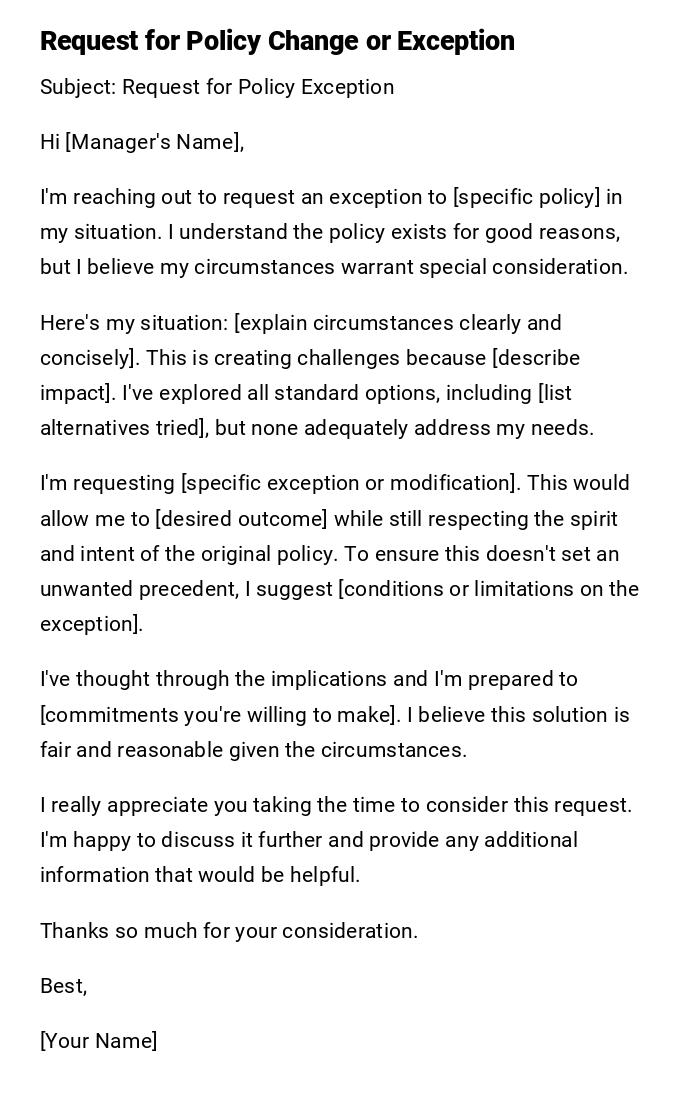
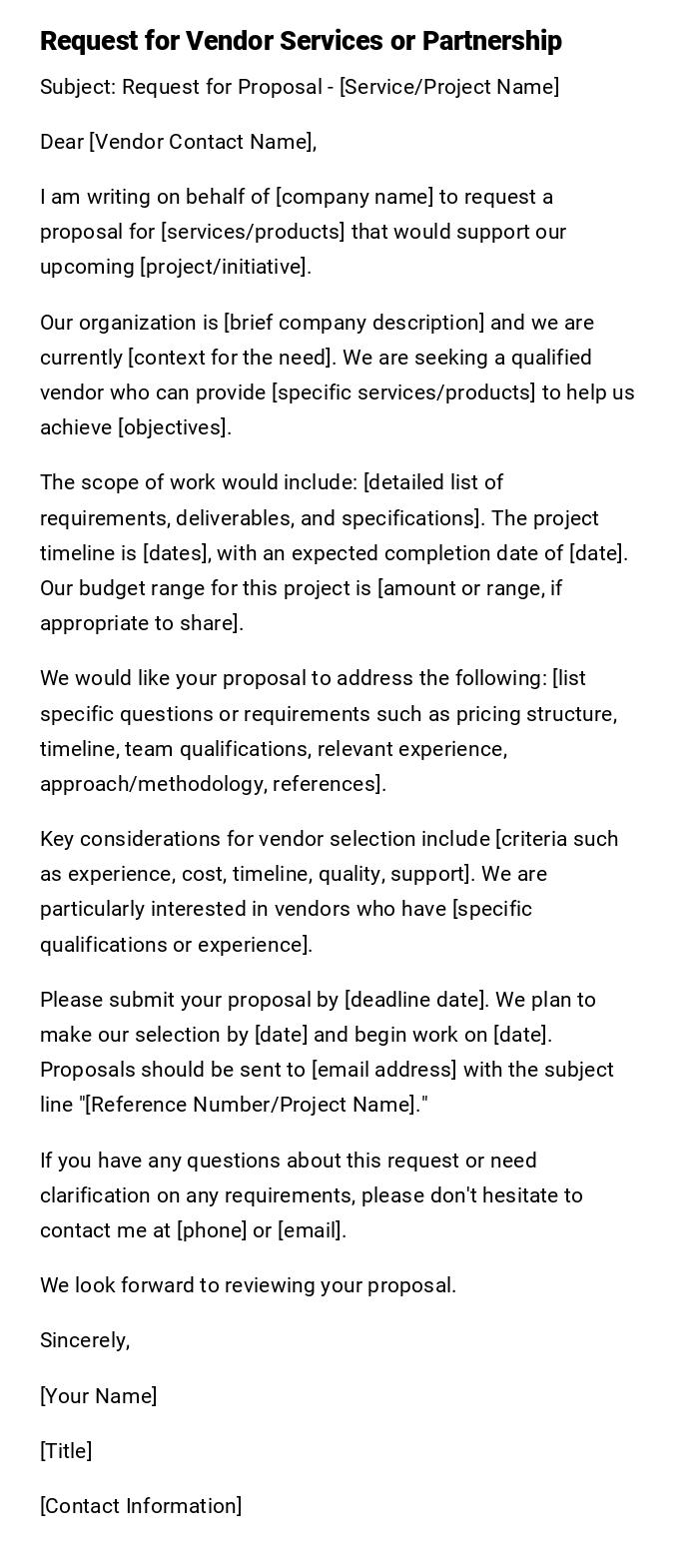
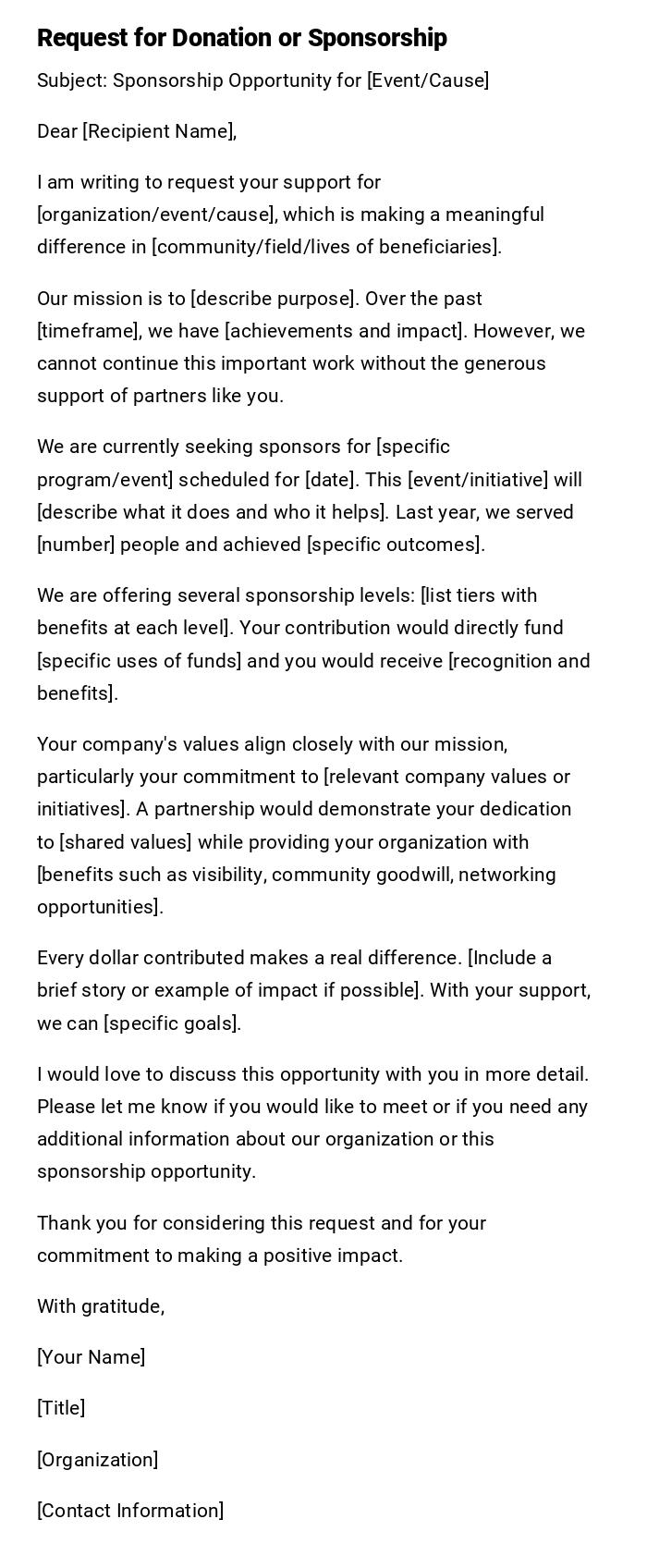

 Download Word Doc
Download Word Doc
 Download PDF
Download PDF